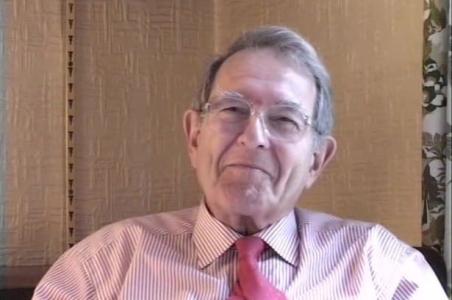
John Goldsmith was born in Oberkassel near Dusseldorf, Germany, his father a grain importer, his mother a dentist. His parents divorced and he moved with his mother to Dusseldorf in 1928. his mother remarried, but his stepfather was murdered by a rival Nazi dentist in 1933. Following the murder he and his widowed mother moved to live with an uncle to Amsterdam where he went to school and learnt Dutch. Fortunately, in 1938 his mother was accepted as a refugee dentist in the UK They settled in Cambridge where Goldsmith attended the Leys School and learnt English - in that order!
At the time of Dunkirk, on his 16th birthday, he was interned as an alien refugee in Huyton, Liverpool; three of his fellow inmates being future Fellows of the Royal Society! He was soon transferred to the Isle of Man and later to Canada remaining there in detention until 1941 when he was shipped back to the UK to lead a free life and return to schooling. The underlying wisdom of imposing on him these various moves remains obscure!
Undeterred by a tumultuous adolescence and even though he had naturally as a child experienced some anti-semitism, he retained a sense of happiness and interest in life which remained defining characterics. He passed the requisite exams to join Guys Dental School but in his first term transferred to medicine. His evident talent was recognised and he became houseman to the eminent neurologist Sir Charles Symonds who, learning that John did not have private means, discouraged him from embarking on any specialisation in those, pre-NHS days .He did not follow Symonds advice but persisted, later worked under Francis Avery Jones and Richard Asher at the Central Middlesex Hospital.
With characteristic resourcefulness, after not getting shortlisted for jobs as Goldschmidt, he anglicised the name when his naturalisation papers came through in 1947. As Goldsmith he noted an immediate Increase in interest in employing him! He obtained MRCP, volunteered for service. and spent time with the RAMC in Egypt, returning to a post at Queen Elizabeth Hospital, Birmingham and later at Great Ormond Street.
Always fascinated by the kidney, he published in the Lancet a familial outbreak of glomerulonephritis while a medical senior registrar in Sheffield, and was invited to work with Wilhelm Kolff and then Robert Kark in the USA, both pioneers of renal medicine.
In 1962 he was appointed consultant physician at Sefton General Hospital, Liverpool, with responsibility for the newly established artificial kidney unit. As was the case in several centres, this unit had been started by a urologist, James Cosbie-Ross; it was equipped with one Skeggs-Leonard dialyser and one bed, offering treatment for patients with acute renal failure. But already the possibility of long-term dialysis for those with chronic renal failure was being demonstrated and Goldsmith having visited the pioneer, Belding Scribner in Seattle, became one of the early practitioners of this new, life-saving therapy in the UK and then of its extension into home dialysis. The service needed both to expand and to undertake research and he set up the Mersey Kidney Research Fund with the help of an influential patient. Cosbie-Ross also used his contacts in Liverpool to bring other influence to bear and this Fund, the first such to be set up in the UK, has remained a major supporter of the renal service in Liverpool, providing salaries for research fellows and for equipment.
In 1979, Sefton General Hospital closed but the Renal Service remained there awaiting funding to transfer this now large and respected service to the new Royal Liverpool Hospital (RLH). NHS financial constraints precluded this and the service was in danger of imploding as it could not survive in a now otherwise empty acute hospital. Goldsmith responded with typical resilience, addressing a meeting of the Ford Halesowen factory workers in the rain one lunchtime having learnt that they intended to distribute £190,000 from their charitable fund to a variety of Liverpool charities. Goldsmith persuaded them to donate the whole sum to the Renal Service, invested it wisely for a year and having used it as a security for NHS funding returned the whole sum to the NHS once the unit at RLH was complete. The service has prospered ever since with a strong link to renal transplantation initially under Robert Sells, and a steady research output. Goldsmith loved teaching and his enthusiasm and wide experience made him a sought after educator.
Although he had fought his corner fiercely to enable his service to prosper, his colleagues recognised his fairness and natural flair for organisation and he was invited in 1986 to become the first medical manager of the RLH, a post he occupied with distinction. After formal retirement, he continued to work clinically in the Liverpool conurbation, a valuable addition to any local hospital service.
He was a keen musician and for many years a member of the Royal Liverpool Philharmonic Choir. He also maintained a large garden. In late life he loved cooking, often entertaining friends to skilfully prepared meals.
Goldsmith enjoyed family life. He married twice and although twice divorced, he remained on excellent terms with his former wives, his three children, two stepchildren and their offspring. During much of his retirement he enjoyed the companionship of Christine who survives him.